Hua Huang
NVIDIA Nemotron Nano 2: An Accurate and Efficient Hybrid Mamba-Transformer Reasoning Model
Aug 21, 2025



Abstract:We introduce Nemotron-Nano-9B-v2, a hybrid Mamba-Transformer language model designed to increase throughput for reasoning workloads while achieving state-of-the-art accuracy compared to similarly-sized models. Nemotron-Nano-9B-v2 builds on the Nemotron-H architecture, in which the majority of the self-attention layers in the common Transformer architecture are replaced with Mamba-2 layers, to achieve improved inference speed when generating the long thinking traces needed for reasoning. We create Nemotron-Nano-9B-v2 by first pre-training a 12-billion-parameter model (Nemotron-Nano-12B-v2-Base) on 20 trillion tokens using an FP8 training recipe. After aligning Nemotron-Nano-12B-v2-Base, we employ the Minitron strategy to compress and distill the model with the goal of enabling inference on up to 128k tokens on a single NVIDIA A10G GPU (22GiB of memory, bfloat16 precision). Compared to existing similarly-sized models (e.g., Qwen3-8B), we show that Nemotron-Nano-9B-v2 achieves on-par or better accuracy on reasoning benchmarks while achieving up to 6x higher inference throughput in reasoning settings like 8k input and 16k output tokens. We are releasing Nemotron-Nano-9B-v2, Nemotron-Nano12B-v2-Base, and Nemotron-Nano-9B-v2-Base checkpoints along with the majority of our pre- and post-training datasets on Hugging Face.
Revealing Latent Information: A Physics-inspired Self-supervised Pre-training Framework for Noisy and Sparse Events
Aug 07, 2025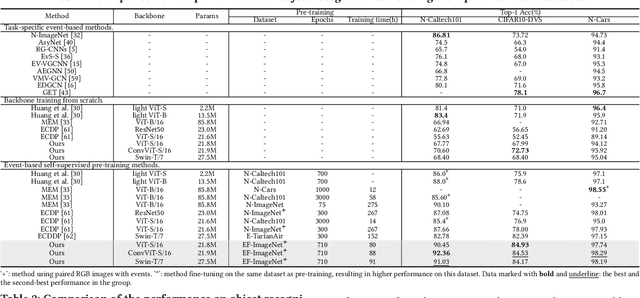

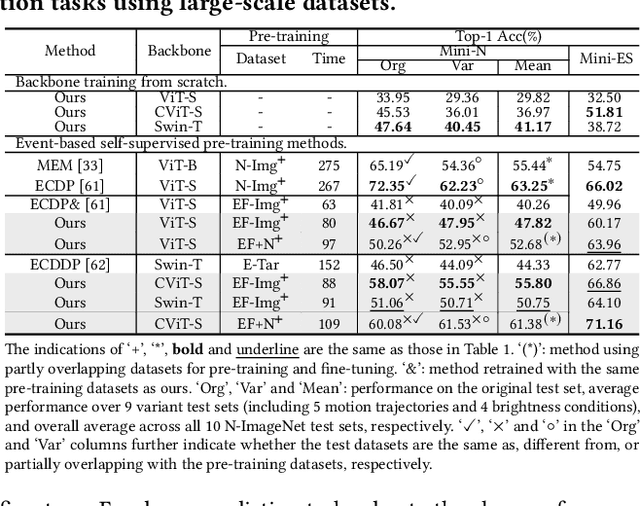

Abstract:Event camera, a novel neuromorphic vision sensor, records data with high temporal resolution and wide dynamic range, offering new possibilities for accurate visual representation in challenging scenarios. However, event data is inherently sparse and noisy, mainly reflecting brightness changes, which complicates effective feature extraction. To address this, we propose a self-supervised pre-training framework to fully reveal latent information in event data, including edge information and texture cues. Our framework consists of three stages: Difference-guided Masked Modeling, inspired by the event physical sampling process, reconstructs temporal intensity difference maps to extract enhanced information from raw event data. Backbone-fixed Feature Transition contrasts event and image features without updating the backbone to preserve representations learned from masked modeling and stabilizing their effect on contrastive learning. Focus-aimed Contrastive Learning updates the entire model to improve semantic discrimination by focusing on high-value regions. Extensive experiments show our framework is robust and consistently outperforms state-of-the-art methods on various downstream tasks, including object recognition, semantic segmentation, and optical flow estimation. The code and dataset are available at https://github.com/BIT-Vision/EventPretrain.
VisioMath: Benchmarking Figure-based Mathematical Reasoning in LMMs
Jun 07, 2025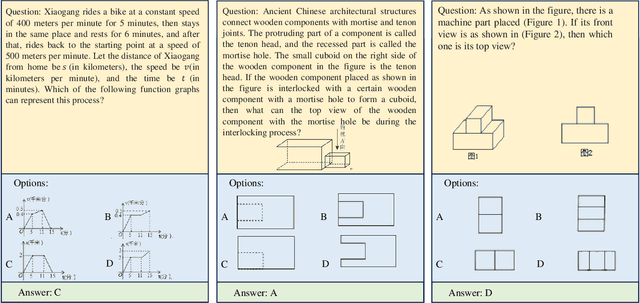
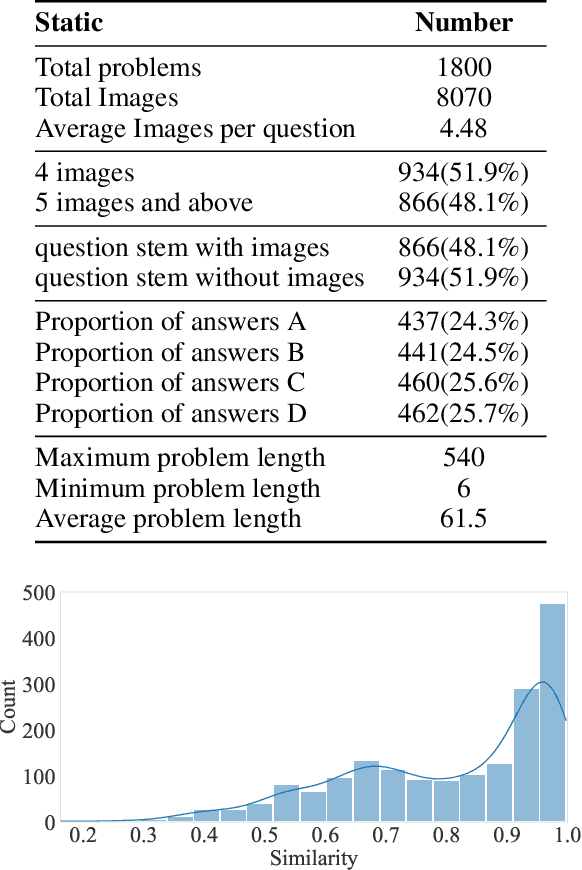
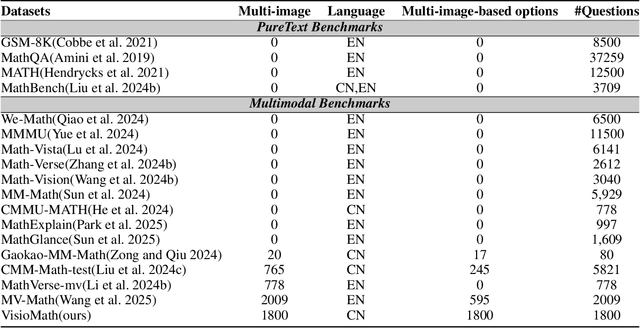
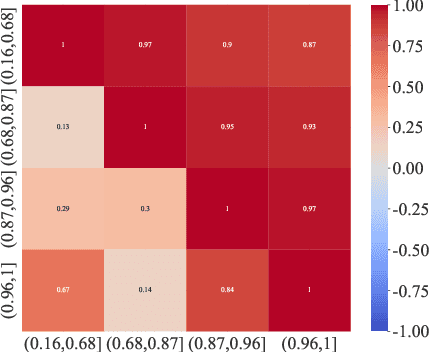
Abstract:Large Multimodal Models (LMMs) have demonstrated remarkable problem-solving capabilities across various domains. However, their ability to perform mathematical reasoning when answer options are represented as images--an essential aspect of multi-image comprehension--remains underexplored. To bridge this gap, we introduce VisioMath, a benchmark designed to evaluate mathematical reasoning in multimodal contexts involving image-based answer choices. VisioMath comprises 8,070 images and 1,800 multiple-choice questions, where each answer option is an image, presenting unique challenges to existing LMMs. To the best of our knowledge, VisioMath is the first dataset specifically tailored for mathematical reasoning in image-based-option scenarios, where fine-grained distinctions between answer choices are critical for accurate problem-solving. We systematically evaluate state-of-the-art LMMs on VisioMath and find that even the most advanced models struggle with this task. Notably, GPT-4o achieves only 45.9% accuracy, underscoring the limitations of current models in reasoning over visually similar answer choices. By addressing a crucial gap in existing benchmarks, VisioMath establishes a rigorous testbed for future research, driving advancements in multimodal reasoning.
PDE: Gene Effect Inspired Parameter Dynamic Evolution for Low-light Image Enhancement
May 14, 2025



Abstract:Low-light image enhancement (LLIE) is a fundamental task in computational photography, aiming to improve illumination, reduce noise, and enhance image quality. While recent advancements focus on designing increasingly complex neural network models, we observe a peculiar phenomenon: resetting certain parameters to random values unexpectedly improves enhancement performance for some images. Drawing inspiration from biological genes, we term this phenomenon the gene effect. The gene effect limits enhancement performance, as even random parameters can sometimes outperform learned ones, preventing models from fully utilizing their capacity. In this paper, we investigate the reason and propose a solution. Based on our observations, we attribute the gene effect to static parameters, analogous to how fixed genetic configurations become maladaptive when environments change. Inspired by biological evolution, where adaptation to new environments relies on gene mutation and recombination, we propose parameter dynamic evolution (PDE) to adapt to different images and mitigate the gene effect. PDE employs a parameter orthogonal generation technique and the corresponding generated parameters to simulate gene recombination and gene mutation, separately. Experiments validate the effectiveness of our techniques. The code will be released to the public.
APG-MOS: Auditory Perception Guided-MOS Predictor for Synthetic Speech
Apr 29, 2025Abstract:Automatic speech quality assessment aims to quantify subjective human perception of speech through computational models to reduce the need for labor-consuming manual evaluations. While models based on deep learning have achieved progress in predicting mean opinion scores (MOS) to assess synthetic speech, the neglect of fundamental auditory perception mechanisms limits consistency with human judgments. To address this issue, we propose an auditory perception guided-MOS prediction model (APG-MOS) that synergistically integrates auditory modeling with semantic analysis to enhance consistency with human judgments. Specifically, we first design a perceptual module, grounded in biological auditory mechanisms, to simulate cochlear functions, which encodes acoustic signals into biologically aligned electrochemical representations. Secondly, we propose a residual vector quantization (RVQ)-based semantic distortion modeling method to quantify the degradation of speech quality at the semantic level. Finally, we design a residual cross-attention architecture, coupled with a progressive learning strategy, to enable multimodal fusion of encoded electrochemical signals and semantic representations. Experiments demonstrate that APG-MOS achieves superior performance on two primary benchmarks. Our code and checkpoint will be available on a public repository upon publication.
TSGS: Improving Gaussian Splatting for Transparent Surface Reconstruction via Normal and De-lighting Priors
Apr 17, 2025Abstract:Reconstructing transparent surfaces is essential for tasks such as robotic manipulation in labs, yet it poses a significant challenge for 3D reconstruction techniques like 3D Gaussian Splatting (3DGS). These methods often encounter a transparency-depth dilemma, where the pursuit of photorealistic rendering through standard $\alpha$-blending undermines geometric precision, resulting in considerable depth estimation errors for transparent materials. To address this issue, we introduce Transparent Surface Gaussian Splatting (TSGS), a new framework that separates geometry learning from appearance refinement. In the geometry learning stage, TSGS focuses on geometry by using specular-suppressed inputs to accurately represent surfaces. In the second stage, TSGS improves visual fidelity through anisotropic specular modeling, crucially maintaining the established opacity to ensure geometric accuracy. To enhance depth inference, TSGS employs a first-surface depth extraction method. This technique uses a sliding window over $\alpha$-blending weights to pinpoint the most likely surface location and calculates a robust weighted average depth. To evaluate the transparent surface reconstruction task under realistic conditions, we collect a TransLab dataset that includes complex transparent laboratory glassware. Extensive experiments on TransLab show that TSGS achieves accurate geometric reconstruction and realistic rendering of transparent objects simultaneously within the efficient 3DGS framework. Specifically, TSGS significantly surpasses current leading methods, achieving a 37.3% reduction in chamfer distance and an 8.0% improvement in F1 score compared to the top baseline. The code and dataset will be released at https://longxiang-ai.github.io/TSGS/.
Mixture of Group Experts for Learning Invariant Representations
Apr 12, 2025Abstract:Sparsely activated Mixture-of-Experts (MoE) models effectively increase the number of parameters while maintaining consistent computational costs per token. However, vanilla MoE models often suffer from limited diversity and specialization among experts, constraining their performance and scalability, especially as the number of experts increases. In this paper, we present a novel perspective on vanilla MoE with top-$k$ routing inspired by sparse representation. This allows us to bridge established theoretical insights from sparse representation into MoE models. Building on this foundation, we propose a group sparse regularization approach for the input of top-$k$ routing, termed Mixture of Group Experts (MoGE). MoGE indirectly regularizes experts by imposing structural constraints on the routing inputs, while preserving the original MoE architecture. Furthermore, we organize the routing input into a 2D topographic map, spatially grouping neighboring elements. This structure enables MoGE to capture representations invariant to minor transformations, thereby significantly enhancing expert diversity and specialization. Comprehensive evaluations across various Transformer models for image classification and language modeling tasks demonstrate that MoGE substantially outperforms its MoE counterpart, with minimal additional memory and computation overhead. Our approach provides a simple yet effective solution to scale the number of experts and reduce redundancy among them. The source code is included in the supplementary material and will be publicly released.
GCRayDiffusion: Pose-Free Surface Reconstruction via Geometric Consistent Ray Diffusion
Mar 28, 2025Abstract:Accurate surface reconstruction from unposed images is crucial for efficient 3D object or scene creation. However, it remains challenging, particularly for the joint camera pose estimation. Previous approaches have achieved impressive pose-free surface reconstruction results in dense-view settings, but could easily fail for sparse-view scenarios without sufficient visual overlap. In this paper, we propose a new technique for pose-free surface reconstruction, which follows triplane-based signed distance field (SDF) learning but regularizes the learning by explicit points sampled from ray-based diffusion of camera pose estimation. Our key contribution is a novel Geometric Consistent Ray Diffusion model (GCRayDiffusion), where we represent camera poses as neural bundle rays and regress the distribution of noisy rays via a diffusion model. More importantly, we further condition the denoising process of RGRayDiffusion using the triplane-based SDF of the entire scene, which provides effective 3D consistent regularization to achieve multi-view consistent camera pose estimation. Finally, we incorporate RGRayDiffusion into the triplane-based SDF learning by introducing on-surface geometric regularization from the sampling points of the neural bundle rays, which leads to highly accurate pose-free surface reconstruction results even for sparse-view inputs. Extensive evaluations on public datasets show that our GCRayDiffusion achieves more accurate camera pose estimation than previous approaches, with geometrically more consistent surface reconstruction results, especially given sparse-view inputs.
Pi-GPS: Enhancing Geometry Problem Solving by Unleashing the Power of Diagrammatic Information
Mar 07, 2025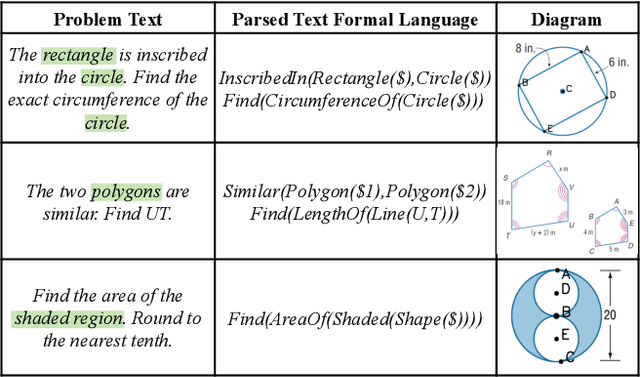



Abstract:Geometry problem solving has garnered increasing attention due to its potential applications in intelligent education field. Inspired by the observation that text often introduces ambiguities that diagrams can clarify, this paper presents Pi-GPS, a novel framework that unleashes the power of diagrammatic information to resolve textual ambiguities, an aspect largely overlooked in prior research. Specifically, we design a micro module comprising a rectifier and verifier: the rectifier employs MLLMs to disambiguate text based on the diagrammatic context, while the verifier ensures the rectified output adherence to geometric rules, mitigating model hallucinations. Additionally, we explore the impact of LLMs in theorem predictor based on the disambiguated formal language. Empirical results demonstrate that Pi-GPS surpasses state-of-the-art models, achieving a nearly 10\% improvement on Geometry3K over prior neural-symbolic approaches. We hope this work highlights the significance of resolving textual ambiguity in multimodal mathematical reasoning, a crucial factor limiting performance.
HiGP: A high-performance Python package for Gaussian Process
Mar 04, 2025Abstract:Gaussian Processes (GPs) are flexible, nonparametric Bayesian models widely used for regression and classification tasks due to their ability to capture complex data patterns and provide uncertainty quantification (UQ). Traditional GP implementations often face challenges in scalability and computational efficiency, especially with large datasets. To address these challenges, HiGP, a high-performance Python package, is designed for efficient Gaussian Process regression (GPR) and classification (GPC) across datasets of varying sizes. HiGP combines multiple new iterative methods to enhance the performance and efficiency of GP computations. It implements various effective matrix-vector (MatVec) and matrix-matrix (MatMul) multiplication strategies specifically tailored for kernel matrices. To improve the convergence of iterative methods, HiGP also integrates the recently developed Adaptive Factorized Nystrom (AFN) preconditioner and employs precise formulas for computing the gradients. With a user-friendly Python interface, HiGP seamlessly integrates with PyTorch and other Python packages, allowing easy incorporation into existing machine learning and data analysis workflows.
 Add to Chrome
Add to Chrome Add to Firefox
Add to Firefox Add to Edge
Add to Edge